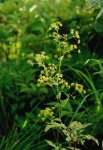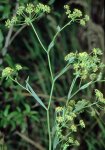Bupleurum l.
Family Celery (Apiaceae) - Umbelliferae
Botanical characteristics. Perennial or annual herbaceous plant. It grows on wet meadows, on slopes, seaside cliffs.
The root is powerful, pivotal. Stem straight, up to 1 m high. Leaves basal are longer, middle and upper are shorter than lower ones. Flowers with curled inward petals. Fruit is the seed. Blossoms in June - July, fructifies in July - August.
There are several species. The most curative are:
- Long-rayed cordura - V. longiradiatum T. Leaves are medium stem, oblong-ovate, upper narrower. At the base of the leaves are expanding and deeply growing. A flower calyx wrap consists of 1-5 leaves, which soon fall out. Umbrella of 8-12 rays, light yellow, sometimes white.
- Volosushka kozeletselistnaya - V. scorzonerifolium W. Leaves are dense, linear, located in a vertical plane, with prominent parallel veins, narrowed toward the base. Leaflets of the wrapper are lanceolate, very small. Umbrellas are white, small.
All kinds of volostushki are used in medicine, but more often volodushka long-leaved and kozelecelistnaya .
Used parts of the plant. Medicinal raw materials are roots, the aerial part, leaves, flowers, fruits. The aerial part is collected at the beginning of flowering, bundled into bundles and dried in dryers at a temperature of 70-100 ° C.
Chemical composition. All parts of the plant contain a large number of flavonoids, especially many in flowers: querceti, isoramnetin and their glycosides (rutin, narcissine), as well as their derivatives, vitamins.
The roots contain phenolic compounds, coumarins, carbohydrates, saponins, polyacetylene compounds.
In the aboveground part, leaves and flowers are tannins, phenolcarbonic acids, steroids, coumarins, carbohydrates. Fruits contain fatty oil, saponins, essential oil.
Application. The roots of the long-rayed and goat-leaved fiber in Chinese, Korean and Tibetan medicine are used for diseases of the heart, liver, bladder, infectious and female diseases, impotence, flatulence, as an antiplatelet, diaphoretic, antitumor, anti-inflammatory, diuretic; With gastrointestinal diseases, headache, dizziness; Externally - with eye diseases, dermatoses.
In folk medicine, the plant has been known for a long time as an effective choleretic agent, it is used for diseases of the liver and gallbladder, as a mild laxative and stimulating the nervous system. Outwardly, fresh plant juice is used to treat pustular skin diseases.
In the experiment, the preparations of the volostushki strengthen and normalize the permeability of the blood capillaries.
A preparation called "Buplerin" was obtained from the grass of the cell. It is recommended for use in medicine as a P-vitamin (expanding capillaries and vessels), normalizes the increased permeability of the blood capillaries, is used for atherosclerosis, cardiovascular diseases and in ophthalmology for the treatment of eye diseases. From the fruits of the parietal, the preparation "Pecovorin" was also obtained, which has a pronounced choleretic property. It contributes to the normalization of liver function, has a normalizing effect on the enzymatic system of blood in hepatitis.
The voles of the goat leaves is a part of the components of the most common complex formulations of traditional oriental medicine as a tonic and restorative means.
The aerial part in the form of infusions and decoctions is used as a lactogenic, astringent, anthelmintic, choleretic, wound-healing agent.
Preparation
- To obtain a decoction, take 15 g of roots, grind, pour 180 ml of boiling water, insist on a boiling water bath for 30 minutes, cool for 10 minutes, filter, bring to 180 ml. Take 1/3 cup 2-3 times a day after meals.
- For infusion of 20 g of the aboveground part is crushed, pour 200 ml of boiling water, insist on a water bath for 15 minutes, cool for 45 minutes, filter. Take 1/3 cup 3 times a day.




Comments
When commenting on, remember that the content and tone of your message can hurt the feelings of real people, show respect and tolerance to your interlocutors even if you do not share their opinion, your behavior in the conditions of freedom of expression and anonymity provided by the Internet, changes Not only virtual, but also the real world. All comments are hidden from the index, spam is controlled.